Pics of historical miniatures and historical content produced by a Northern Virginia Public Historian
Don't wanna be here? Send us removal request.
Text

James Graham, Marquis of Montrose, and Alasdair Mac Colla of Clan Donald: A duo for the ages. The two rampaged through the western highlands of Scotland in 1644-45 as leaders in the royalist movement in the north during the English Civil War. Clansmen wrestled with their Covenanter enemies for control of Argyll, with some clan fueds being fed by the civil war. With Montrose’s Irish Legion and Mac Colla’s Highlanders, these forces were unparalleled in their ferocity, and many villages and towns throughout the highlands were left as piles of cinder in their wake.
Eventually their actions would catch up with them, with Montrose’s hanging in Edinburgh in 1645, and Mac Colla’s execution in Ireland in 1647.
#history#miniatures#military history#historic miniatures#english civil war#scotland#scottish#marquess of montrose
2 notes
·
View notes
Text





Loudoun, Fauquier, and Prince William County men of the 3rd Virginia Regiment of the Continental Line as they would’ve appeared in 1778. As one of the most veteran regiments of the Continental Army, the 3rd served with distinction at battles such as Harlem Heights, White Plains, Trenton, Princeton, Brandywine, Monmouth, and the Siege of Charleston.
During the Battle of Brandywine on Sept 11, 1777, the 3rd Virginia held the line at the Birmingham Meeting house, where dozens of men were killed buying time for Washington to pull his army out to survive another day. At that same battle, Fauquier County resident Captain John Ashby of the 3rd saved General Lafayette after being wounded.
The third’s uniform in 1778 was described in deserter ads as Based on a description in the Pennsylvania Packet as a "light blue drab coat with pale blue facings, green vest, and linen overalls"
Models are Perry Miniatures using Vallejo paints.
#3rdvirginiaregiment#history#miniatures#military history#historic miniatures#americanrevolution#america250#americanhistory#virginia250#virginia
5 notes
·
View notes
Text
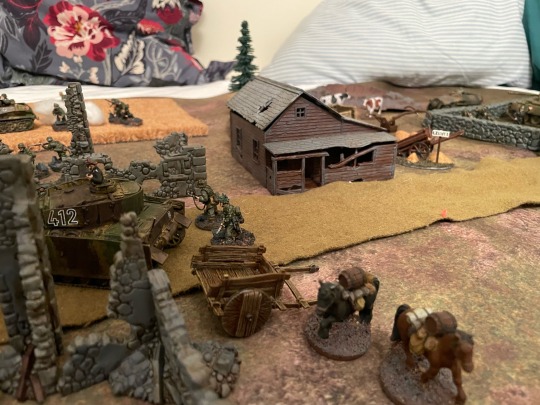
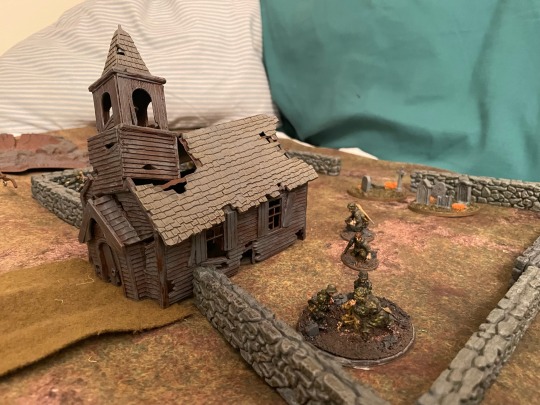
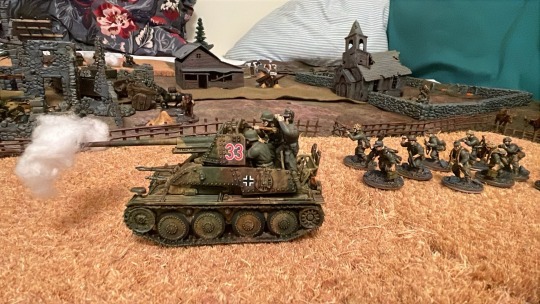
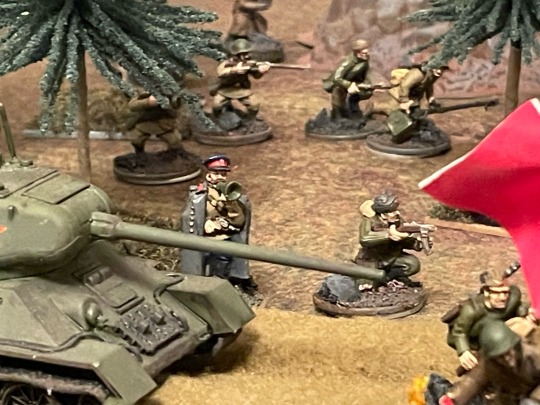
#history#miniatures#military history#historic miniatures#world war 2#world war ii#germanarmy#russia#sovietunion
12 notes
·
View notes
Text
Been working on some terrain pieces for an Eastern Front scenario.




#russian#sovietunion#history#miniatures#military history#historic miniatures#world war 2#world war ii#germanarmy#russia#stalin#russian army
9 notes
·
View notes
Text





Soldiers of the 1st Battalion, Black Watch, part of the 51st Highland Division in Northwest Europe. This is how they would’ve looked sometime in 1944-45. The 51st was a well seasoned division whose veteran corps derived from all over Scotland. When war broke out in September, 1939, the 51st was positioned on the French Maginot Line, a series of defensive works along the French-German border. In the Spring of 1940, as the Germans pushed the British Expeditionary Force through Belgium and into Dunkirk, the 51st was in a fighting withdrawl with the French Army. After the majority of the BEF withdrew from Dunkirk, the 51st fought with the french to St Valery, in northern Normandy. Unfortunately there were practically no rescue efforts to get the highlanders out, and they would he surrounded and captured by the 7th Panzer Division then commanded by General Erwin Rommel.
Over 10,000 men were captured from the 51st, and they would spend the next 5 years in POW Camps.
Back home in Scotland in August, General “Tartan Tam” Douglas Wimberley set to work reforming the Division pulling men from all over Scotland and ensuring the scottish pride of the division would be reborn. The Division then fought in every major campaign until the war’s conclusion, including North Africa, Sicily, Italy, Normandy, and the Rhine.
#scotland#history#miniatures#military history#historic miniatures#world war 2#world war ii#highlander#scottish#51st highlanders
20 notes
·
View notes
Text


A Marder III and other German armor as it would have looked in Northwest Europe in 1944-45.
9 notes
·
View notes
Text



An M-10 Tank Destroyer and other vehicles that would have been part of Task Force Sugar during the fight in Brest, France in the late summer of 1944.
#history#miniatures#military history#historic miniatures#world war 2#world war ii#us army#tank destroyer
9 notes
·
View notes
Text



German Panzer Grenadiers 1943-45.
5 notes
·
View notes
Text





More Italians, supported by a Panzer III of the 10th Panzer Division.
#history#miniatures#military history#historic miniatures#world war 2#italian history#italian army#italy#world war ii#ww2 history#ww2#tanks
5 notes
·
View notes
Text





Italian Infantry as they would have appeared in North Africa in 1942. They are supported by a Semovente tankette.
#history#miniatures#military history#historic miniatures#world war 2#italian army#italy#italian history#mussolini
9 notes
·
View notes
Text



Men of the Duchy of Warsaw’s 13th Infantry marching through a recently captured village in the Russian Steppe, and encountering a small party of Russian jagers.
#history#miniatures#military history#historic miniatures#napoleon#poland#polish#french army#russian#russia#tsar alexander i
5 notes
·
View notes
Text



Soviet troops in the Eastern Front 1941-45.
#history#miniatures#military history#historic miniatures#world war 2#russia#russian#sovietunion#soviet union#soviet art#stalin#stalingrad#eastern front
7 notes
·
View notes
Text



More work on Infantrymen of the Empire of Japan.
This is not honoring the army of Japan, nor condoning their actions. To learn about their many warcrimes, please visit https://frank-cho-foundation.github.io

#history#miniatures#military history#historic miniatures#japanese history#japanese#japan#world war 2#pacific theater#iwo jima
3 notes
·
View notes
Text




Japanese Infantry and a Type 97 Chi-Ha tank, 1943.
#japan#japanese#history#miniatures#military history#historic miniatures#world war 2#pacific theater#japanese history
6 notes
·
View notes
Text





“There is nothing heard now up and down the kingdom but alarms and rumores, randevouses of clans. Montross and MacKoll in every manes mouth, nay the very children frightened"
Clan MacDougall serving under Alasdair Mac Colla in 1644-45, supporting the royalist cause in Scotland.
#history#miniatures#military history#historic miniatures#english civil war#mac colla#montrose#james graham#marquess of montrose#ireland#scotland#clan macdougall#clan donald#clan campbell
29 notes
·
View notes
Text



Grenadiers of the Pavlovski Life Guards Regiment, a title given to the unit after its actions at the Battle of Borodino, at which the inflicted heavy damage on a French column in the village of Utitska and initially repulsing them before ultimately retreating. This Russian regiment served in all major campaigns of the Napoleonic Wars in which their country was involved, and served with distinction in the Hanover Expedition, Battle of Eylau, and the battle of Klyastitsi.
Models are Warlord Games, using Vallejo Model Color paints.
#history#miniatures#military history#historic miniatures#napoleon#russia#tsar alexander i#napoleonic wars#napoleonic era
22 notes
·
View notes
Text
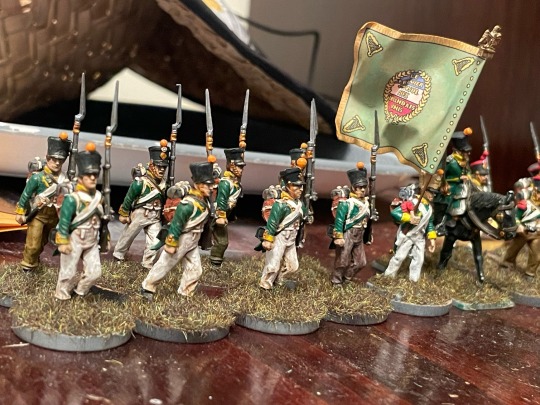
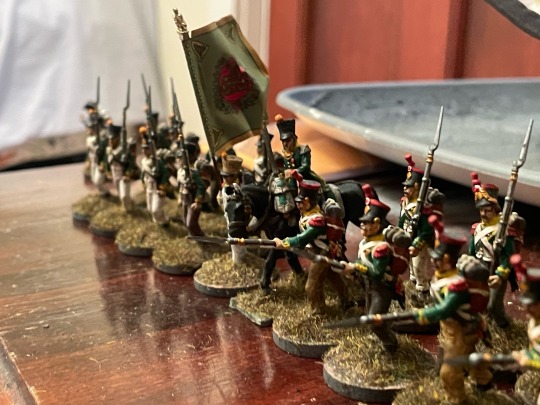
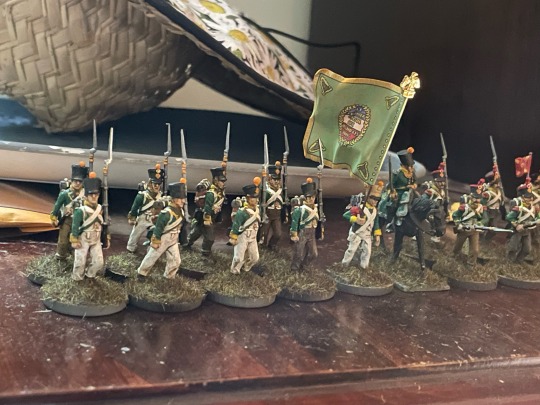
Men of the Irish Legion in Napoleon’s grande armee. These troops were largely of those who escaped after the failed 1798 rebellion in Ireland. The legion was meant to be the core of a force to invade England and Ireland under Napoleon in 1803, but the naval Battle of Trafalgar ended any seaborne plans of invasion.
The Irish Legion continued service in the Grande Armee, serving in the Netherlands, Peninsula War, and the 1813 German campaign.
#history#miniatures#military history#historic miniatures#napoleon#irish history#ireland#irish legion#1798 rebellion
6 notes
·
View notes